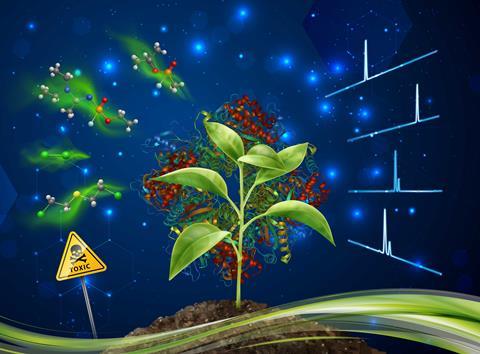If there has been an attack with chemical weapons somewhere, you should be able to see it in the leaves of plants. Dutch researchers have demonstrated this in Analytical Methods.
In spite of the fact that the use of chemical weapons has been banned, they are still being used. But it is impossible to confirm whether chemical weapons have been used somewhere on the basis of rumours. With funding from the Dutch Ministry of Defence and the Organisation for the Prohibition of Chemical Weapons (OPCW), Mirjam de Bruin-Hoegée, Arian van Asten and colleagues from the University of Amsterdam and TNO Defense, Safety and Security have found a way to deduce from plants whether chemical weapons have been used.
This is because plants tend to form so-called adducts with substances in their environment; they do not move, of course, and so they can sometimes be used as an environmental diary. The researchers set up a closed, safe facility to expose different plants to a range of concentrations of dangerous gases and liquids. These included mustard gas, sarin, chlorine gas and Novichock A-234, which they administered in either vapour or liquid form to stinging nettle, bay leaf or basil leaves.
The most abundant protein in the world, found in almost all plants, is also affected by the toxic gases.
’These adducts remain detectable for up to three months after administration,’ says Mirjam de Bruin-Hoegée, first author and PhD student. ’This is quite extraordinary, since the difficult thing about looking for evidence of chemical weapons use is that these substances disappear quickly. This applies to substances in the bodies of victims, but also to intact substances in the environment.’
However, plants preserve protein adducts: amino acids – in this case histidine and tyrosine – from specific proteins that react with a part of the chemical weapon. These adducts can then be recovered using liquid chromatography combined with tandem mass spectrometry (LC-MS/MS), and the researchers verified the plant adducts with synthesised variants. In addition, there was very little difference between the plant species, which suggests to them that this method can be applied to more plant species.
Outdoors
In the article, the authors point out that this is obviously not an outdoor laboratory. But De Bruin-Hoegée expects the technique to work in practice. ‘The concentration in the leaves will vary a bit more,’ the PhD student says. ‘In the lab, we know exactly how much gas or liquid we have produced; in the outdoors, it will vary from place to place. So you may need to do some pre-screening, looking at leaf discolouration, for example, to see where the best place is to take samples. In the laboratory we were always looking at two leaves at a time, but obviously it is possible to study the whole plant. One of the proteins that was affected by the toxic gases is the RUBISCO protein, which is the most abundant protein in the world, found in almost all plants, so the technique should be almost universally applicable.’
There are still some open questions, mainly related to the situation after a chemical weapons attack. De Bruin-Hoegée: ‘Many chemical weapons have been used in Syria, including chlorine gas. But after such an attack, bleach is often used for cleaning, which of course also contains chlorine. As a result, there are a few biomarkers that are the same after treatment with bleach or chlorine gas, so we need to find other biomarkers that show the difference.’ But then, of course, the plants will have to be present.
In any case, the current technique is already being taken up internationally. ‘We have many collaborations outside the Netherlands,’ says De Bruin-Hoegée. ’A large number of them have also responded that they want to apply our research in practice if the need arises. It is great to see that this does not stay in the Netherlands, but that it is used more and more all over the world.’
De Bruin-Hoegée, M. et al. (2023) Analytical Methods 2, doi.org/10.1039/D2AY01650H














Nog geen opmerkingen